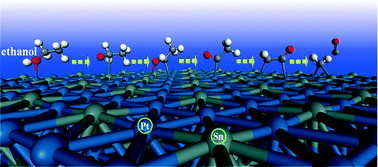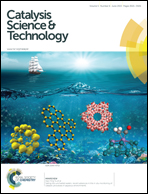CO tolerance of a Pt3Sn(111) catalyst in ethanol decomposition†
Abstract
CO tolerance is one of the crucial factors to protect catalysts against inactivation during ethanol decomposition processes. Herein, the intrinsic essence of CO tolerance and the effect of the alloying element Sn in Pt3Sn(111) are investigated by combining periodic density functional theory (DFT) and microkinetic modelling. It is found that the most competitive route to CO proceeds via CH3CH2OH → CH3CH2O → CH3CHO → CH3CO → CH2CO → CH2 + CO. Resulting from the decomposition of easily-oxidized CH3CO and hard-forming but readily-desorbed CH2CO, and the less competitive C–C bond scission occurring before Cα–H, Cβ–H, and O–H bond scission, the formation of CO is not facile on Pt3Sn(111). The alloying element Sn plays “bifunctional” and “ligand effect” roles to effectively strengthen O-end species adsorption, adjust the alloy electronic structures and weaken the Pt–CO bonds, thus facilitating CO elimination from Pt3Sn(111). Microkinetic modelling confirms the substantially high CO tolerance of Pt3Sn, and easy desorption of the most abundant species such as CH2CO and CH2 from the surface above room temperature. This theoretical work sheds new light on the CO tolerance of Pt3Sn(111) in ethanol decomposition and provides a fresh perspective on understanding the effect of alloying elements.


 Please wait while we load your content...
Please wait while we load your content...